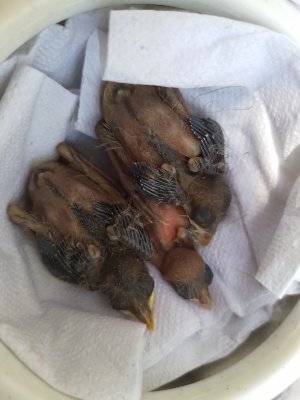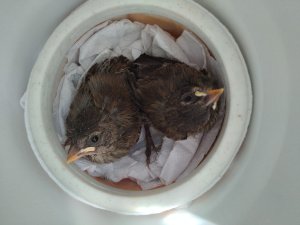18 healthy Mangrove Finch fledglings leave the nest: a sign of hope for this critically endangered species
Our Mangrove Finch conservation team is pleased to share that 18 healthy and strong fledglings of the critically endangered Mangrove Finch (Camarhynchus heliobates) have fledged successfully from a total of nine nests during this 2023 breeding season. This represents one of the most successful seasons since the conservation project began in 2007, led by the Charles Darwin Foundation (CDF) in collaboration with the Galapagos National Park Directorate (GNPD). This is also the first year since the 2020 pandemic with significant reproductive success.

The Mangrove Finch is one of the 17 species of "Darwin's finches" that only exist in the Galapagos Islands. It is the rarest bird in the archipelago with an estimated population of less than 100 individuals inhabiting just 30 hectares across two locations on Isabela Island. The Mangrove Finch is classified as critically endangered by the International Union for Conservation of Nature (IUCN). Its main known threats are the Avian Vampire Fly (Philornis downsi) and the black rat (Rattus rattus), both introduced species.
Francesca Cunninghame, who leads the Mangrove Finch conservation project at CDF, comments: "Having 18 Mangrove Finch fledglings fledge successfully and see them foraging behind their parents in the mangroves of Playa Tortuga Negra and Caleta Black, is great news for the species as it represents a significant increase for the small population. This great achievement is testament to the field team’s efforts and dedication.”
Francesca and her team camped on Isabela Island for a period of two months, during the peak of the Mangrove Finch breeding season, to control introduced species and do everything possible to increase chick survival. The team identified 16 breeding pairs and treated their nests with an insecticide to reduce parasitism from the Avian Vampire Fly larvae (Philornis downsi), which feeds on the blood of nestlings, often causing all chicks in a nest to die. Fortunately, all nests that the team located were treated using technical tree climbing to enhance the treatment’s effectiveness.

Francesca adds: “We faced some challenges and found that all the chicks were infested with the Avian Vampire Fly larvae. But thanks to the techniques used to ensure the survival of each brood, we managed to ensure the success of nine nests - a true team effort."
Some of the nesting birds observed this year are former fledglings of nests that had been treated in earlier nesting seasons by the project team, as well as birds raised in captivity from 2014 to 2017, which demonstrates the effectiveness of the different management techniques that the project has implemented over the years.
Besides caring for the chicks in their nests, the conservation team conducted control of introduced rats, evaluated control techniques for other introduced species, and trialed new techniques to treat nests such as the use of external spray. They also evaluated the feasibility of using drones for future nest treatments, in collaboration with Skylines. Finally, in collaboration with Ilka Feller from the Smithsonian Institute and Nicolas Moity from CDF’s marine program, the team conducted comprehensive monitoring of the mangrove habitat which the Mangrove Finch depends on for its survival.
Francesca concludes: “It is critical that we continue our efforts to protect Mangrove Finch chicks, as they continue to be at their most vulnerable due to parasitism from the Avian Vampire Fly. Facilitating their successful fledging from nests in their natural environment, guided by adult birds, is crucial to increase the young Mangrove Finch’s chances of survival during their first year of life.”
The Mangrove Finch restoration project is funded by Re:wild, the Galapagos Conservation Trust, Peter and Kris Norvig, FEIG and COmON Foundation.
The conservation of the Mangrove Finch remains a priority in the fight to protect biodiversity in the Galapagos. Find out more about the Mangrove Finch Conservation Project here.
For media, please contact:
Charles Darwin Foundation
Leslie León, Communications Officer
leslie.leon@fcdarwin.org.ec | +593 96 978 7679
Galapagos National Park Directorate
Rosa León, Information officer
rleon@galapagos.gob.ec | +593 96 985 4231
About the Charles Darwin Foundation and its Research Station
Since 1959, the Charles Darwin Foundation has worked in close partnership with the Galapagos National Park Directorate to protect the Islands’ natural resources and share scientific results for the conservation of this living laboratory. More than one hundred scientists, educators, researchers, support personnel and volunteers from all over the world have participated in this effort. Currently, more than 75% of the staff are Ecuadorian citizens. The Charles Darwin Foundation is committed to the professional development of permanent Galapagos residents as future scientists, for the well-being of the islands and the nation in general.





